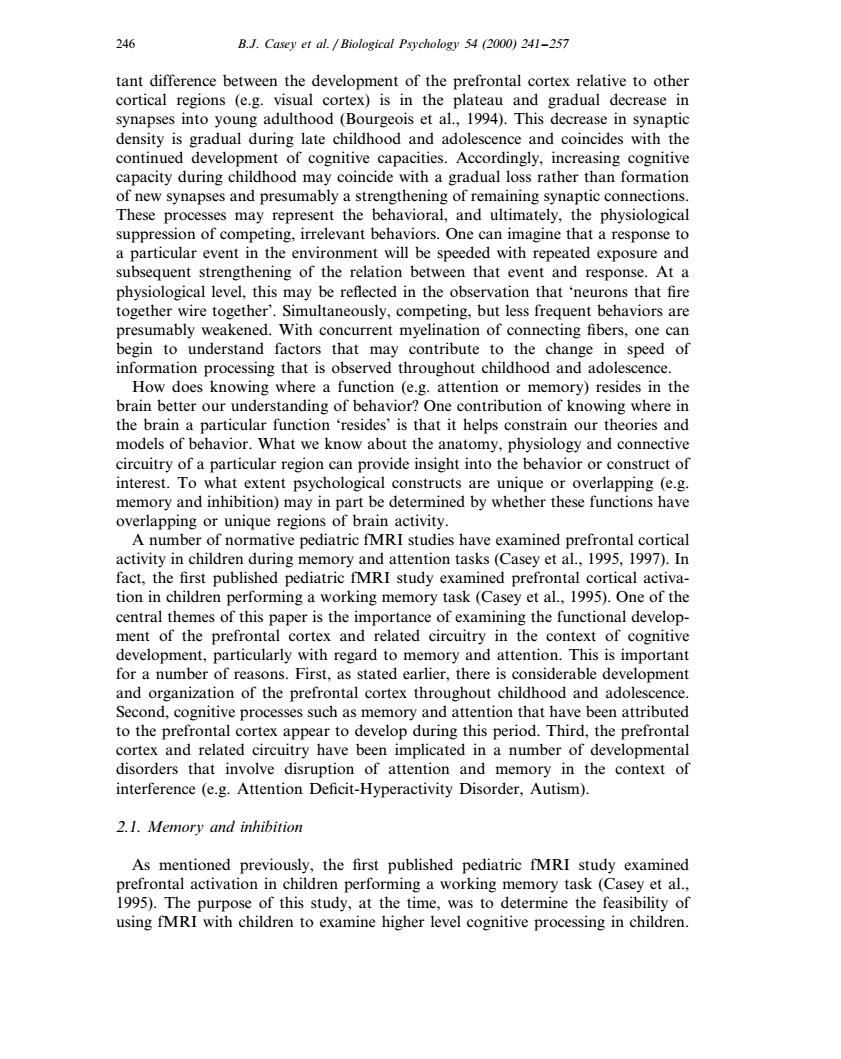正在加载图片...

246 B.J.Casey et al./Biological Psychology 54(2000)241-257 tant difference between the development of the prefrontal cortex relative to other cortical regions (e.g.visual cortex)is in the plateau and gradual decrease in synapses into young adulthood (Bourgeois et al.,1994).This decrease in synaptic density is gradual during late childhood and adolescence and coincides with the continued develop ent of c ognitive Accordingly with a gradual los rather an forma 101 new synapses and presumably a strengthening of rem aining synaptic conn These processes may represent the behavioral,and ultimately,the physiologica suppression of competing,irrelevant behaviors.One can imagine that a response to a particular event in the environment will be speeded with repeated exposure and subsequent strengthening of the relation between that event and response.At a physiological level,this may be reflected in the observation that'neurons that fire together wire together'.Simultaneousl but less frequent be haviors are ably w d With urre conne on gin to understand cha of information processing that is observed throughout childhood and adolescence. How does knowing where a function (e.g.attention or memory)resides in the brain better our understanding of behavior?One contribution of knowing where in the brain a particular function 'resides'is that it helps constrain our theories and models of behavior.What we know about the anatomy,physiology and connective circuitry of a particular region can provide insight into the behavior or construct of interes To hat cho onstruct un: ory and inhibition)may in part be deterr tions have overlapping or unique region in activity A number of normative pediatric fMRI studies have examined prefrontal cortical activity in children during memory and attention tasks (Casey et al.,1995,1997).In fact.the first published pediatric fMRI study examined prefrontal cortical activa tion in children performing a working memory task(Casey et al.,1995).One of the central themes of this paper is the importance of examining the functional develop- ent of the prefror tal and related ci itr in context of cogni regard to Thi importan a nun s.F as stated rlier, there i and organization of the prefrontal cortex throughout childhood and adolescence Second,cognitive processes such as memory and attention that have been attributed to the prefrontal cortex appear to develop during this period.Third,the prefrontal cortex and related circuitry have been implicated in a number of developmental disorders that involve disruption of attention and memory in the context of interference (e.g.Attention Deficit-Hyperactivity Disorder,Autism). 2.1.Memory and inhibition As mentioned previously,the first published pediatric fMRI study examined prefrontal activation in children performing a working memory task(Casey et al., 1995).The purpose of this study,at the time,was to determine the feasibility of using fMRI with children to examine higher level cognitive processing in children. 246 B.J. Casey et al. / Biological Psychology 54 (2000) 241–257 tant difference between the development of the prefrontal cortex relative to other cortical regions (e.g. visual cortex) is in the plateau and gradual decrease in synapses into young adulthood (Bourgeois et al., 1994). This decrease in synaptic density is gradual during late childhood and adolescence and coincides with the continued development of cognitive capacities. Accordingly, increasing cognitive capacity during childhood may coincide with a gradual loss rather than formation of new synapses and presumably a strengthening of remaining synaptic connections. These processes may represent the behavioral, and ultimately, the physiological suppression of competing, irrelevant behaviors. One can imagine that a response to a particular event in the environment will be speeded with repeated exposure and subsequent strengthening of the relation between that event and response. At a physiological level, this may be reflected in the observation that ‘neurons that fire together wire together’. Simultaneously, competing, but less frequent behaviors are presumably weakened. With concurrent myelination of connecting fibers, one can begin to understand factors that may contribute to the change in speed of information processing that is observed throughout childhood and adolescence. How does knowing where a function (e.g. attention or memory) resides in the brain better our understanding of behavior? One contribution of knowing where in the brain a particular function ‘resides’ is that it helps constrain our theories and models of behavior. What we know about the anatomy, physiology and connective circuitry of a particular region can provide insight into the behavior or construct of interest. To what extent psychological constructs are unique or overlapping (e.g. memory and inhibition) may in part be determined by whether these functions have overlapping or unique regions of brain activity. A number of normative pediatric fMRI studies have examined prefrontal cortical activity in children during memory and attention tasks (Casey et al., 1995, 1997). In fact, the first published pediatric fMRI study examined prefrontal cortical activation in children performing a working memory task (Casey et al., 1995). One of the central themes of this paper is the importance of examining the functional development of the prefrontal cortex and related circuitry in the context of cognitive development, particularly with regard to memory and attention. This is important for a number of reasons. First, as stated earlier, there is considerable development and organization of the prefrontal cortex throughout childhood and adolescence. Second, cognitive processes such as memory and attention that have been attributed to the prefrontal cortex appear to develop during this period. Third, the prefrontal cortex and related circuitry have been implicated in a number of developmental disorders that involve disruption of attention and memory in the context of interference (e.g. Attention Deficit-Hyperactivity Disorder, Autism). 2.1. Memory and inhibition As mentioned previously, the first published pediatric fMRI study examined prefrontal activation in children performing a working memory task (Casey et al., 1995). The purpose of this study, at the time, was to determine the feasibility of using fMRI with children to examine higher level cognitive processing in children